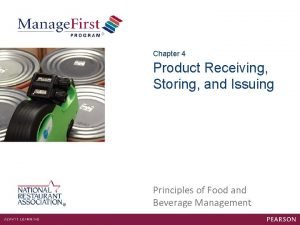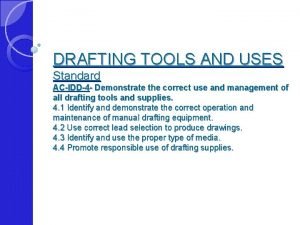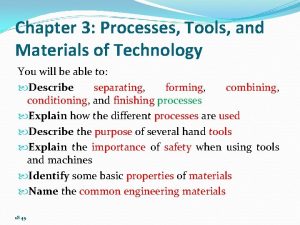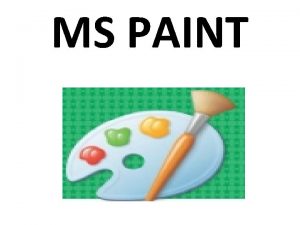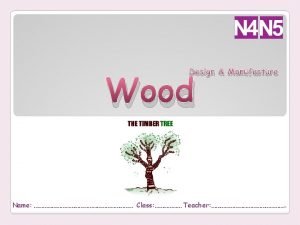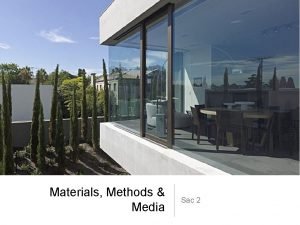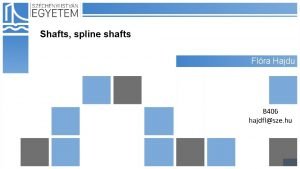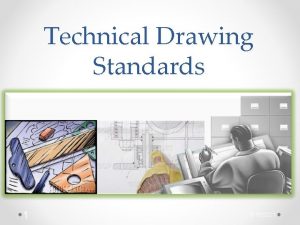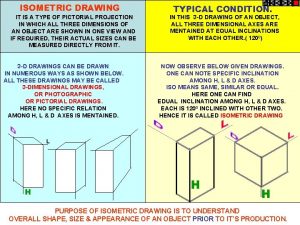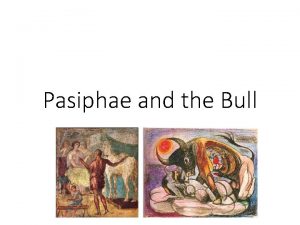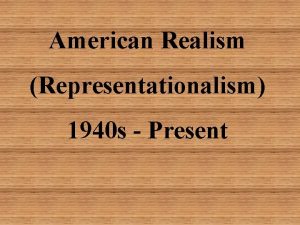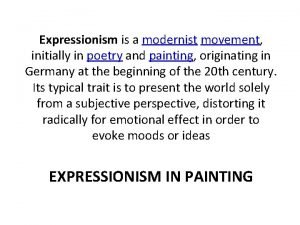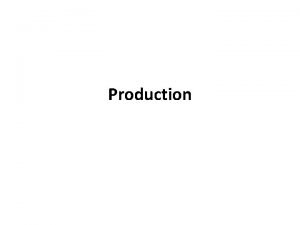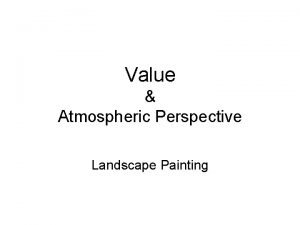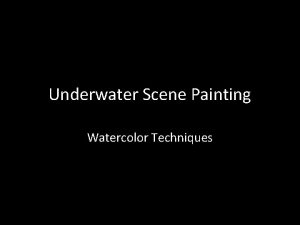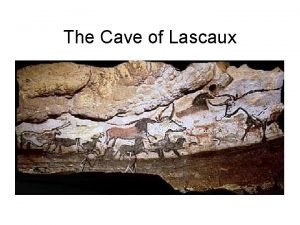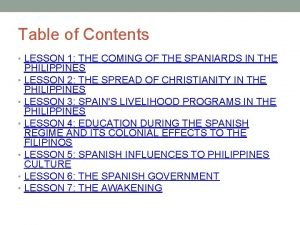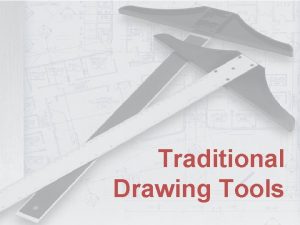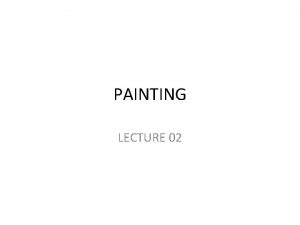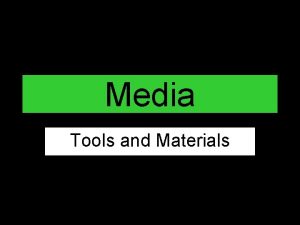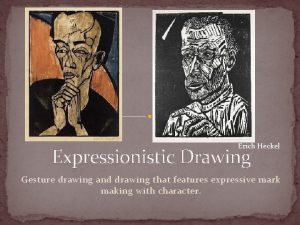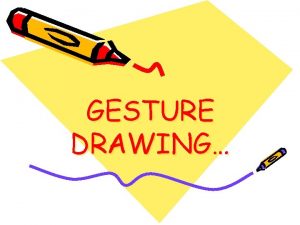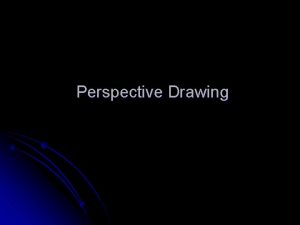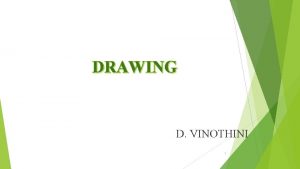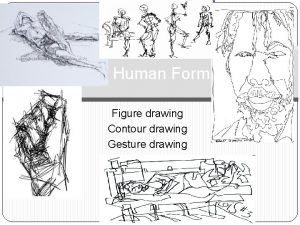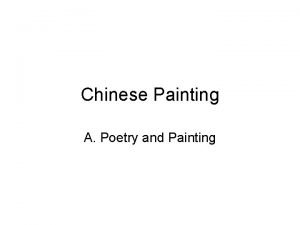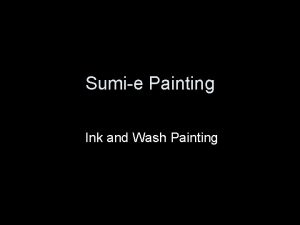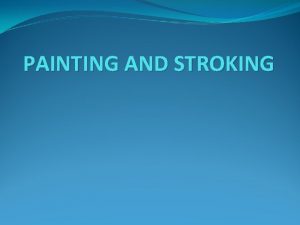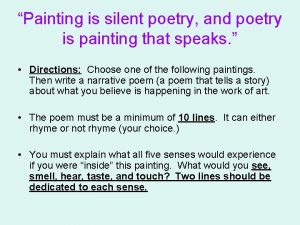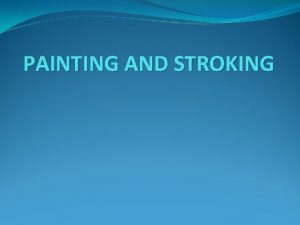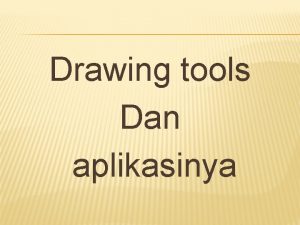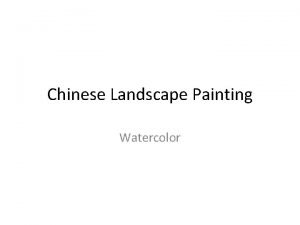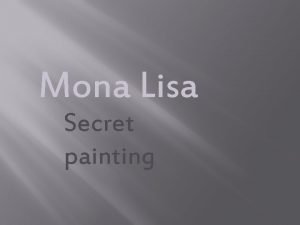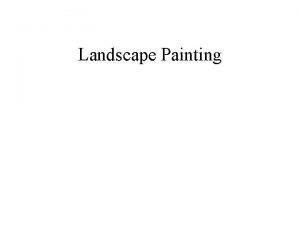Media Tools and Materials Drawing Media Painting Media





































- Slides: 37

Media: Tools and Materials Drawing Media Painting Media Printmaking Media Sculpture Media Crafts

Drawing: Pencil Drawing with a lead pencil dates back to Roman times. This versatile tool can be used to make quick sketches as well as polished, finished drawings of great detail. This portrait of Thomas Church by French artist Ingres combines many pencil techniques in one work: light and heavy lines, carefully shaded areas as well as planes defined only by contour lines. 1816, 7 x 6”

Drawing: Charcoal The soft, grainy quality of charcoal is evident in Georges Seurat’s 1885 drawing done on textured paper. Charcoal comes in sticks, or can be made in a pencil format. It smudges easily, and that characteristic can be employed for artistic effect.

Drawing: Ink Pure ink can create a very dark black value, or it can be diluted with water to create various degrees of gray. Japanese and Chinese artists applied ink washes with a paint brush. Sesshu, Haboku Landscape, ink on paper, 1400 s, 28” tall

Drawing: Ink Dutch artist Vincent van Gogh used a pen made from a hollow reed to create his landscape drawing in the late 1800 s. Notice the variety of marks he employed to create different visual textures.

Drawing: Pastel Oil pastels are a dry material, similar to chalk, but more slick. The final result looks like a colored drawing. Mary Cassatt’s 1910 Sleeping Baby has delicate shading, light value colors and a sketchy, dry-textured quality. 25 x 20”

Painting: Fresco is one of the oldest painting formats; water-based tempera paint is applied directly onto a wet plaster wall. Fresh plaster is applied only to the area to be painted that day, because when the plaster dries, it will not absorb the paint. The pigment makes a permanent bond with the lime in the plaster, thus becoming part of the wall, rather than being a “skin” of paint applied to its surface.

Painting: Tempera has been in use for thousands of years; it is water-based, but has often been mixed with egg yolk to give it more permanence and durability. This paint can be built up in luminous, glowing layers. Tempera dries quickly, and typically produces a hard-edge look. Sandro Boticelli’s Birth of Venus is a tempera on canvas painting made in 1482, 6 x 9’

Painting: Oil painting came to dominate European art after the 1400 s. In this medium, color pigment is bound with linseed or poppy oil, and can be thinned with turpentine. The oil component causes a slow drying time, allowing the artist to blend paint in a way not possible with tempera. It is easier for artists to produce soft looking, blended areas with oil paint. The paint may be applied in thin, transparent layers called glazes, or in thick layers known as impasto. It is very versatile and permanent. Frans Hals made this oil painting of Yonker Ramp and his Sweetheart in Holland in the 1600 s; he employed a very sensuous technique, showing off his spontaneous-appearing brushwork. This painting is in the Metropolitan Museum in NYC, and measures 41 x 31. ”

Watercolor Painting Watercolor has been used by artists for thousands of years. It was usually considered to be only a sketch medium, used to make studies for more “finished” works in oil or tempera. In the 1800 s, American artist Winslow Homer decided to make his watercolors finished works. Watercolor paint is transparent; when the artist wants to create a white area, the paper is allowed to show through and remain white, rather than adding opaque white paint to the image. After the Hunt, 1892, 19 x 25”

Acrylic Paint Acrylic is a paint which is made of polymer emulsions, a kind of plastic substance. It is thinned and cleaned with water, and dries quickly. Acrylic paint can be applied to canvas or paper in thick coats like oil or tempera, or may be thinned into watercolorlike wash applications. Franklin WIlliams is a contemporary California artist. His acrylic painting, Mind Body Problem, is a 6’ tall canvas.

Collage is a method of making pictures by combining painted images with other materials which are cut up and pasted or glued onto the picture surface. This practice was first popularized in France by Pablo Picasso and Georges Braque in 1912. American artist Romare Bearden cut pictures with textures and colors from magazines to produce collages that make strong social statements. This 1968 collage, called Eastern Barn, combines paper, glue and oil on paper measuring 55 x 44. ”

Printmaking Media The various printmaking techniques began as a way to make many copies of an artwork available to people at a low cost. The many techniques include woodcut, intaglio etching, linocut, lithograph and serigraph.

Woodcut To make a woodcut print, the artist draws on a block of wood, then uses a sharp carving tool and cuts away the part of the image that will remain white. Ink is then rolled into the remaining raised area, blank paper is pressed onto the block, and a mirror image of the block is printed. Hans Holbein was a German artist who created memorable woodcuts such as the one seen here during the 1500 s.

Woodcut A woodcut is called a relief print because the image on the plate projects, or sticks up from the surface.

Woodcuts may also be produced in color; each color requires a separate cut block. Japanese artist Ando Hiroshige created Rain Shower on Ohashi Bridge in 1857. 14” height.

Linocut This relief printmaking method is similar to woodcut, but the material used for the carved printing plate is linoleum. This is much softer than wood and easier to cut. Elizabeth Catlett created The Survivor in 1983. 11 x 10. ”

Intaglio An intaglio print is made from a metal plate into which an artist has etched an image. Using a sharp etching tool, the artist makes lines and scratches into a zinc or copper plate. When the image is complete the plate is inked with a roller. Ink is forced into the indented, etched areas; blank printing paper is dampened and pressed against the plate in a press. Under great pressure, the paper picks up the ink from the grooves and the image is made. Rembrandt’s 1653 etching is titled Christ Crucified Between the Two Thieves, and measures 15 x 18. ”

A freshly-made image being pulled from a modern artist’s printing press. Images are created one at a time.

Lithograph French artist Toulouse-Lautrec employed the lithograph process to create posters used to advertise cafes, bars and nightclubs in Paris during the late 1800 s. A lithograph is made by drawing on a limestone slab with a greasy crayon or ink. Water is spread over the stone and adheres only where there is no greasy substance. A large brayer is then used to roll greasy ink onto the surface; the ink sticks only where there is no water — it sticks to where the image was drawn. A sheet of paper is then put over the slab and run through a lithograph press to create a permanent printed image.

A printmaker inks a lithograph stone before printing an image.

Serigraph, or silkscreen printing, was developed in the United States in modern times. A screen of silk is stretched onto a wooden frame, to which a stencil is then attached. Ink is forced through the stencil with a rubber squeegee. The open parts of the stencil allow the ink to pass through the screen onto blank paper below, and many colors can be added by repeating the process. Andy Warhol used the silkscreen process to make his Pop Art images in the 1960 s. Campbell’s Soup Can, silkscreen on canvas, 35 x 34, ” 1964.


Silkscreen A printmaker uses a rubber squeegee to force colored ink through the stencil attached to a silkscreen onto paper below the wooden frame.

Sculpture Media Sculptors work in a number of ways; they may cut away or carve solid materials (subtractive), they may add and combine pieces (additive), they may shape materials with their hands (modeling), and they may use a mold (casting). Bronze Casting is a method of reproducing a three-dimensional object by pouring a hardening liquid or molten metal into a mold bearing its impression. This is a practice dating back to ancient times. Here the Hindu god of learning and good fortune is depicted in bronze; it is called Dancing Ganesa and was created in India in the 1400 s. It stands 20” tall.

Steel Sheet steel can be cut and welded together to create pieces of various shapes and sizes, and it can be polished to a very shiny finish. American sculptor David Smith created this stainless steel artwork in 1963. It is called Cubi XIII and stands about 10’ tall.

Wood is a very versatile sculpture material which may be carved, nailed, filed, drilled, sanded and glued. It has been used for thousands of years, and can usually be acquired at relatively low cost wherever people live. This carving is 40” wide and was made in New Zealand in the 1700 s.

Marble is an excellent sculptural material, which may be polished to a glasslike, shiny finish, or perhaps left rough and textured. This ancient piece is from the Cyclades Islands of Greece. It is only 9” tall, and was made in 2000 BC.

Plastic Although this figure looks deceptively life-like when seen in person, it is a scultpure made by American artist Duane Hansen in 1981. The figure was cast in a plastic called polyester resin and reinforced with fiberglass. Hansen applied plaster gauze strips directly to the model’s body, which was heavily greased so the plaster would not stick permanently. Flesh-colored resin is painted into the molds and laminated with layers of glass cloth. Hardened casts are assembled to create the finished figure. The hair, uniform, helmet, and cup are all real items. Life-sized.

Crafts Fibers The early process of twining developed from a need for containers, clothing and household objects. Baskets and rugs were twined by Native American tribes, and eventually looms were used for fabric weavings. This craft grew into today’s huge fabric and textile industry. The wool rug seen here was woven by a Navajo craftsperson using traditional tribal designs and colors in the late 1800 s. It is over six feet tall.

Textiles and weavings are created on looms.

Glass Jewelry has long been associated with wealth and prosperity, and is commonly used to enhance personal appearances. Its popularity in human civilization goes back many thousands of years; Egyptians used glass beads and precious gems in jewelry.

Glass This glass bottle shaped like a fish is 6” tall. It is from Egypt and dates back to 1370 BC.

Clay Various types of clays are dug from the earth, then modeled into a desired shape, dried and fired in a high-temperature oven called a kiln. Earliest examples were flash-fired in an open pit. When fired, clay becomes hard and durable. The objects may be decoratively painted with enamel before firing. This Native American Hopi vessel was made around 1900.

Furniture is often taken for granted, but many fine pieces have been created throughout history by greatly skilled and creative artisans. It may be elegantly simple or elaborate; styles have changed over time and from country to country. Intricate designs may be created with thin strips of wood called veneer. Cutting and fitting veneer into designs is a craft called marquetry. French craftsman Jean. Francois Oeben built this piece in 1763.

Mosaics can be made of glass, colored bits of marble, pieces of ceramic tile, wood, or even seeds and paper. The walls and ceilings of early Christian churches were lined with mosaics of colored glass and sometimes gold. Bits of glass, called tesserae, were embedded in plaster to make designs and pictures which glittered in the candlelight. This is the Church of St. Apollinaire in Ravena, Italy, c. 549.

Metalwork Craftspersons use many different kinds of metals to produce works of art, including gold, silver, copper, bronze, iron, steel and aluminum. This Islamic candlestick was made during the 1200 s; it is engraved brass with silver and gold inlays, 10” tall.
 The virtual instructor
The virtual instructor Purchasing, receiving, storing and issuing comes under
Purchasing, receiving, storing and issuing comes under Simple electrical gadgets and their uses
Simple electrical gadgets and their uses Cant stop the feeling go noodle
Cant stop the feeling go noodle Recognizing useful and harmful materials
Recognizing useful and harmful materials Man made map
Man made map Adapting and adopting materials
Adapting and adopting materials Marking gauge classification
Marking gauge classification This drafting tool is used when drawing vertical lines
This drafting tool is used when drawing vertical lines Direct materials budget with multiple materials
Direct materials budget with multiple materials Resistant materials tools
Resistant materials tools Tools equipment and processes
Tools equipment and processes Isometric projection and orthographic projection
Isometric projection and orthographic projection Introduction of technical drawing
Introduction of technical drawing Sewing tools measuring tools
Sewing tools measuring tools Pencil tool in paint
Pencil tool in paint Classification of chisel
Classification of chisel Screencastify shortcuts
Screencastify shortcuts Methods media and materials
Methods media and materials 5 trends in media and information
5 trends in media and information Free hand sketch engineering drawing
Free hand sketch engineering drawing Scale chapter in engineering drawing
Scale chapter in engineering drawing Technical drawing spline shaft drawing
Technical drawing spline shaft drawing Artistic drawing vs technical drawing
Artistic drawing vs technical drawing Kinds of isometric drawing
Kinds of isometric drawing Pasiphae and the bull painting
Pasiphae and the bull painting Redlin and son painting inc
Redlin and son painting inc Was a modernist movement initially in poetry and painting
Was a modernist movement initially in poetry and painting Animation x sheet
Animation x sheet Media centre meaning
Media centre meaning Interactive media authoring tools
Interactive media authoring tools Traditional media monitoring tools
Traditional media monitoring tools Workhorse software
Workhorse software Mass media tools
Mass media tools Atmospheric perspective landscape
Atmospheric perspective landscape Underwater scenery painting
Underwater scenery painting Cave painting symbols
Cave painting symbols La solidaridad painting
La solidaridad painting

